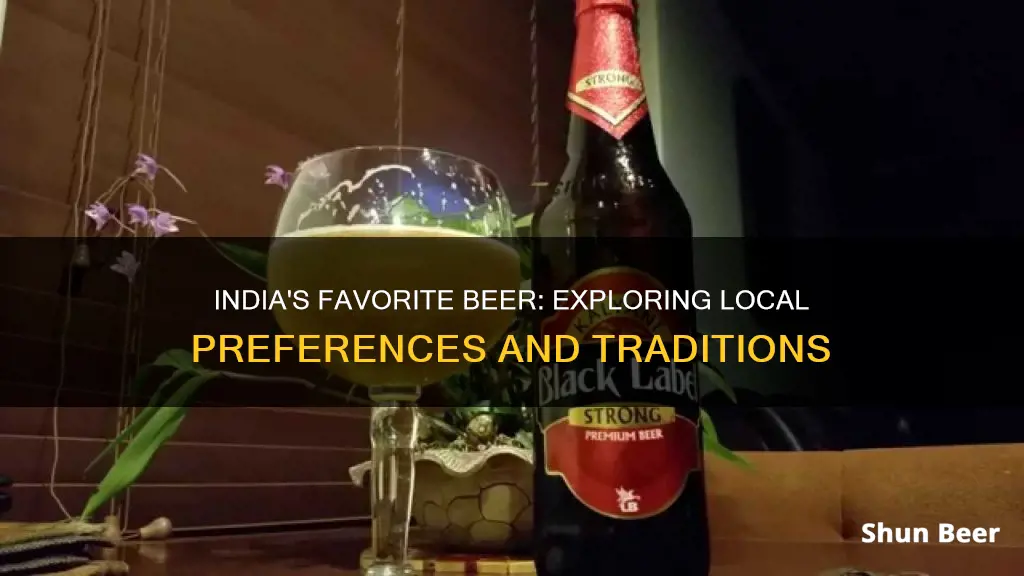
India has a rich history of brewing and consuming alcoholic drinks. While drinking alcohol was traditionally prohibited in Indian culture and restricted to important events, the country has seen a shift towards a more Western drinking culture. Today, Indians are known to favour strong alcoholic drinks, with liquor and beers with a high alcohol content dominating the market.
Beer in India has been prepared from rice or millet for thousands of years, and the country has its own traditional beer-like drinks, such as sura, medaka, and prasanna. In the 18th century, the British introduced European-style beer to India, and the first Indian-brewed European beer, Lion beer, was produced in the 1820s. Since then, the Indian beer market has grown and diversified, with a range of local and international brands available today.
What You'll Learn

India's most popular beers
India has a rich history of brewing and consuming alcoholic drinks. While drinking alcohol was traditionally prohibited in Indian culture and restricted to important events, today, Indians have adopted a more western drinking culture.
Beer in India has been prepared from rice or millet for thousands of years. In the 18th century, the British introduced European beer to the country. However, beer is not as popular as stronger alcoholic drinks like desi daru and Indian-made foreign liquor, such as whiskey. Indians typically prefer stronger alcoholic drinks as they are cheaper and have a higher alcohol content. In fact, strong beer, with an alcohol content of 5 to 8 percent, accounted for 83 percent of all beer sold in India in 2012.
Kingfisher
Kingfisher is the largest-selling and best-known beer brand in India. Manufactured by United Breweries Group, it is an easy-going lager with a bitter taste that lingers pleasantly on the palate, complemented by an underlying malty sweetness. It has a refreshing light taste, which is probably why it is so popular among beer enthusiasts. Its variants include Kingfisher Strong (8% alcohol), Kingfisher Premium (4.8% alcohol), Kingfisher Blue (8% alcohol), and Kingfisher Ultra (5% alcohol).
Tuborg
Tuborg is a bottom-fermented lager beer with an alcohol percentage of 4.8%. It has a mild, fresh taste with a floral aroma. This medium-rich and lively drink has a moderate bitterness in the aftertaste, making it a good choice to pair with light meals like salads and spicy Asian dishes.
Carlsberg
Carlsberg is another light-tasting beer, known as a Pilsener with a malty backbone and balanced bitterness. It is a pale yellow lager that leaves a mild, hoppy bitterness on the tongue. The superior-quality European barley gives Carlsberg a unique, rich taste, making it a smooth drinking experience. Its variants include Carlsberg Elephant and Carlsberg Smooth.
Budweiser
Budweiser is one of the best-selling beer brands in India, with a sweet rice flavour and a touch of bitter hops. It has a very light taste, making it perfect for chugging while watching sports or playing games. Its variants include Budweiser Premium (5% alcohol) and Budweiser Magnum (6.5% alcohol).
Haywards 5000
Haywards 5000 is a high-selling beer brand in India, with over 10 million units sold annually. It has a smooth but strong taste and an alcohol percentage of over 7%.
Royal Challenge
Royal Challenge is famous in northern India, particularly in Uttar Pradesh, Odisha, and Andhra Pradesh. This mild beer has a crisp taste and vibrant flavour, brewed for a longer time than other beers, giving it extra flavour. It is prepared using the finest six-malt barley, catering to those with superior taste preferences.
Godfather
Godfather is a well-received beer brand, especially in the northern part of India. It has a smooth, full-bodied flavour with a stable head and good mouthfeel. With an alcohol content of 7.5%, it packs a punch for beer lovers! Its variants include Godfathers Light (5% alcohol), Godfathers Strong (7% alcohol), and Godfathers Lager (5% alcohol).
Bira 91
Bira 91 is a craft beer that has taken the Indian market by storm. It has a low bitterness level and a hint of spicy citrus, with a soft finish. It is a refreshing all-day craft beer with several variants, including Bira Blonde (5% alcohol), Bira White Ale (5% alcohol), Bira Light (4% alcohol), Bira Pale Ale (7% alcohol), and Bira Strong Ale (7% alcohol).
These beers are widely enjoyed by Indians and contribute to the growing beer market in the country.
Beer Tube Screens: How Do They Work?
You may want to see also

Traditional Indian alcoholic drinks
India has a wide variety of traditional alcoholic drinks, with different regions serving drinks made from an eclectic assortment of ingredients, including local spices, flavours, and herbs.
Sura
The Vedas, the Rig Veda, and the Ramayana mention a beer-like drink called sura, which was the favourite of the god Indra. Sura has been produced in India since the Vedic era (c. 1500–1200 BCE).
Rice Beer
Rice beer or handia has been traditionally prepared by various indigenous tribes in India for thousands of years. It is made from rice or millet and is sometimes flavoured with Ruellia suffruticosa. It also has ceremonial use among the Asur people.
Millet Beer
Millet beer is also prepared by some tribes and is believed to have helped keep diseases like beri beri in check.
Desi Daru
Desi daru is one of India's cheapest factory-made alcoholic drinks.
Bangla
Bangla is a distilled country liquor made from starch and sold in West Bengal by government-licensed vendors.
Feni
Feni is an alcoholic beverage made from cashew apple or coconut in Goa.
Mahua
Mahua is made from mahua flowers in Central India.
Apo
Apo is a traditional drink from Arunachal Pradesh made from fermented rice.
Arrack
Arrack is distilled from a wash of palm jaggery, herbs, etc. from Kerala.
Chhaang or Tongba
Chhaang or Tongba is a drink from Sikkim made from grain millet.
Bhaang Lassi
Bhaang lassi is prepared from the leaves and buds of the female cannabis plant.
Other Traditional Alcoholic Drinks
Other traditional Indian alcoholic drinks include Kallu (coconut palm sap from Kerala), Kodo Ko Jaanr (made from finger millet), Laopani (made from fermented rice in Assam), and many more.
Does Romney Enjoy Beer?
You may want to see also

Imported beers in India
Beer is not as popular in India as stronger alcoholic drinks like whiskey, but it has been consumed in the country for thousands of years. In fact, beer-like sura has been mentioned in ancient texts like the Vedas and the Ramayana.
European beer imports to India began in the 18th century, introduced by the British Raj. Pale ale and Burton ale were among the first beers to be imported to India from England. In 1787, Bow Brewery invented India Pale Ale, a beer that could withstand the long journey to India and protect it from spoiling in high temperatures.
Today, imported beers make up a tiny proportion of the total beer market in India, but it is a fast-growing segment. The market leader for imported beers in India is Anheuser-Busch InBev, whose Corona has a 49% market share. Other imported beers available in India include:
- Sol, Edelweiss, Affligem, Dos Equis and Desperados (all Heineken brands)
- Hoegaarden and Stella Artois (both Anheuser-Busch InBev brands)
- Budweiser (United States)
- Carlsberg (Denmark)
- Tuborg (Denmark)
- Amstel (Netherlands)
- Kronenbourg (France)
- Foster's (Australia)
- Cobra (United Kingdom)
- Singha (Thailand)
- Heineken (Netherlands)
- Beck's Ice (Germany)
- Victoria Bitter (Australia)
- London Pride (United Kingdom)
- Peroni (Italy)
- White Rhino (India)
The Science of Beer: Foam Detectors Explained
You may want to see also

Alcohol consumption in India
Arunachal Pradesh has the highest proportion of both men (53%) and women (24%) who drink alcohol. Among women, Arunachal Pradesh is followed by Sikkim (16%), and among men, it is followed by Telangana (43%). Consumption among men is also higher in the upper Brahmaputra region of Assam, districts in Jharkhand and Bastar, and the Chhota Nagpur region of Jharkhand and Odisha.
Alcohol consumption is more common among those from the Scheduled Tribes than from any other caste/tribe groups. Among religious groups, the proportion of men who drink alcohol is higher among those belonging to "other religions" (47%) than among Hindus (20%), Muslims (5%), Christians (28%), Sikhs (23.5%), Buddhists/Neo-Buddhists (24.5%), and Jains (5.9%).
The legal drinking age in India and the laws regulating the sale and consumption of alcohol vary from state to state. Consumption of alcohol is prohibited in the states of Bihar, Gujarat, Nagaland, and Mizoram, as well as the union territory of Lakshadweep. All other Indian states permit alcohol consumption but fix a legal drinking age, which differs by region and type of beverage.
The alcohol market in India consists of two main kinds of liquor: Indian-made Indian liquor (IMIL) and Indian-made foreign liquor (IMFL). This is in addition to beer, wine, and other imported alcohol. Country liquor accounts for the highest market share, while spirits make up the majority of the consumption market. Beer is not as popular as stronger alcoholic beverages like desi daru and IMFL, such as Indian whiskey.
Despite legal restrictions, alcohol consumption in India has risen over 55% in the last 20 years, according to OECD figures. This increase can be attributed to factors such as rising disposable income and a growing urban population. While the average per adult intake of alcohol in India is low compared to other countries, heavy drinking among young Indians is prevalent. Men are more likely to drink than women, and both are prone to episodic drinking. According to a study, over 88% of Indians under 25 purchase or consume alcoholic beverages, even though it is illegal.
Beer Choices of the Financially Challenged: Class and Taste
You may want to see also

History of beer in India
Beer has a long history in India, with records showing that beer-like beverages have been produced and consumed in the region for thousands of years. Here is an overview of the history of beer in India:
Ancient History
The Indian subcontinent has a rich history of brewing, with evidence of beer-like drinks dating back to ancient times. One such drink, called "sura", is mentioned in the Vedas, the ancient Hindu scriptures. Sura is said to have been the favourite beverage of the god Indra and was used in rituals. It was made from fermented barley and rice and flavoured with local fruits and spices. This drink is believed to have been produced since the Vedic era, around 1500 BCE.
Rice beer, or "handia", has also been traditionally prepared by various indigenous tribes in India. Millet beer is another variety that has been brewed by some tribes. The biologist J. B. S. Haldane noted that local beers helped keep diseases like beri-beri at bay in these tribes.
Colonial Period
The introduction of European beer to India occurred in the 18th century with the arrival of the British. However, the hot and humid climate of India posed a challenge for brewing, as the beer often arrived stale or spoiled during the long journey from England. This prompted brewers to create a new style of beer with higher alcohol content and a stronger hop profile to better withstand the journey—the now-famous India Pale Ale (IPA).
George Hodgson's Bow brewery in London played a significant role in the development of IPA. They supplied the beer to the British Indian Army and the East India Company, who demanded a beer that could survive the long voyage to India. Hodgson's beer, a strong, pale ale called "barley wine" or "October beer", was well-received in India, and his brewery became known for supplying beer to the region.
Post-Independence
After India gained independence from Britain in 1947, the country's beer industry continued to evolve. The first lager brewery in India was established in 1928 by Muree Brewery in Rawalpindi (now in Pakistan). However, lager brewing may have begun even earlier, with some sources indicating that E. Dyer & Co. brewed pilsner at their Solan Brewery as early as 1910.
The Indian beer market was initially dominated by light beers with less than 5% alcohol content. Golden Eagle, created by Dyer Meakin Breweries Ltd. (later Mohan Meakin Ltd.) in 1855, was the first beer brand in this category. United Breweries, which opened breweries in Bangalore and West Bengal, introduced the popular Kingfisher brand.
In the 1970s, the rise of strong beer, with alcohol content between 6-8%, began to gain popularity. GURU, produced by Mohan Meakin, was the first strong beer in India and quickly became a market hit. This was followed by other strong beers such as THUNDERBOLT and RAJDHANI. The UB Group, which had a strong presence across India, captured a significant share of the strong beer market.
The entry of multinational companies in the late 1990s and early 2000s further transformed the Indian beer industry. Brands like Foster's, Carlsberg, Tuborg, and Miller introduced premium strong beers to the market, offering consumers a wider range of choices.
Craft Beer Revolution
In recent years, India has witnessed a craft beer revolution, with the first brewpubs opening in Pune and Gurgaon (now Gurugram) in 2009. Bangalore, Mumbai, and other Tier 1 cities soon followed suit, and today, there are close to 150 brewpubs across the country. The craft beer movement has brought a variety of styles, including wheat-based ales, Belgian Wit, blonde ales, pilsners, stouts, and IPAs, to Indian consumers.
While beer remains less popular than stronger alcoholic beverages in India, the industry is growing, driven by increasing disposable income and a growing middle class. The per capita annual beer consumption in India is currently 2.6L/person, but there is potential for growth, especially with the evolving tastes and preferences of Indian consumers.
Mormons and Root Beer: What's the Deal?
You may want to see also
Frequently asked questions
Popular beers in India include Kingfisher, Tuborg, Carlsberg, Budweiser, Heineken, Corona, Bira 91, Fosters, Haywards 5000, Royal Challenge, Kings, Godfather, Stella Artois, Peroni, Daredevil, and Simba.
Traditional Indian alcoholic drinks include Ranu, Apong, cashew nut beer, Zutho, palm tree sap beer, and Arak.
Tea and coffee are widely consumed in India.
Indians traditionally don't drink much compared to other countries, and when they do, it's often to get buzzed. Strong alcoholic drinks are also cheaper than beer in India.
The increase in alcohol consumption in India can be attributed to the adoption of Western drinking culture, higher disposable income, and a growing middle class.







